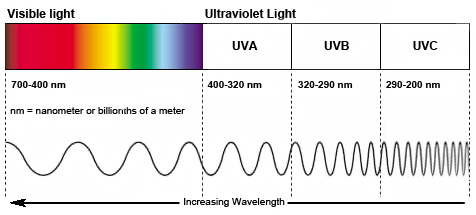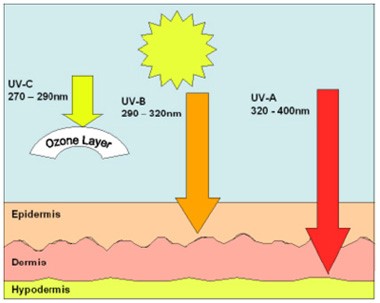The Benefits of the Ozone Layer and the Harmful Effects of UV Radiation
Ultraviolet (UV) light is electromagnetic radiation with a wavelength shorter than that of visible light, but longer than soft x-rays.
The “near” UV spectrum (200-400nm) is divided into three types of radiation, UVC, UVB, and UVA rays, based upon wavelength:
UVC: 200nm – 290nm
UVB: 290nm – 320nm
UVAII: 320nm – 340nm (short-wave UVA)
UVAI: 340nm – 400nm (long-wave UVA)
Sunlight contains all three types of UV radiation: UVC, UVB, and UVA. The ozone layer protects humans from UVC radiation, which would otherwise destroy the skin; but the ozone layer does not protect against UVB or UVA radiation. Because DNA absorbs wavelengths primarily in the UVC range (and to a progressively lesser degree in the UVB and UVA ranges), the ozone layer is crucial to life on earth; without the ozone layer, life as we know it wouldn’t exist.
The Benefits of Ozone
Ozone is a molecular compound made of three oxygen atoms (O3). The ‘ozone layer’ is a natural concentration of ozone in the Earth’s stratosphere between 30,000 and 150,000 feet above the Earth. When a UV ray impacts an ozone molecule, the ozone molecule breaks down into a single oxygen atom (O–) and a separate pair of oxygen molecules (O2), converting the UV radiation to heat. Rapidly afterwards, the oxygen molecule combines with another single oxygen atom to form a new ozone molecule, thus recycling the ozone. This reaction between UV radiation and ozone blocks the majority of UV radiation from reaching the surface of the Earth. Without ozone protection, UV levels would increase dramatically, leading to skin and other cancers, cataracts, and weakened immune systems; high levels of UV radiation would also kill plants and disrupt the ocean’s food chain.
The above diagram is an absorbance curve for DNA through the UV spectrum. UV radiation (especially UVC radiation) has sufficient energy to break molecular DNA bonds and cause mutations. This is why the stratospheric ozone layer is so important – the ozone layer prevents the UVC radiation from striking the Earth. As atmospheric ozone concentrations decrease, the amount of UVC (and UVB) radiation reaching the earth increases, and the risk for mutations, cell destruction, and subsequent cancer increases.
UV Radiation and its Effect on the Skin
Thankfully the ozone layer blocks the UVC rays… But UVB and UVA rays still pass through the clouds and penetrate our skin, causing damage, photoaging and producing skin cancers. Because clouds do not block UV rays, it is the reason why you can still get sunburned on a cloudy or hazy day.
A person’s risk of skin cancer is related to the lifetime exposure of UV radiation. Most skin cancer appears after age 50, but that sun damage began from sun exposure at a much earlier age; and the use of sunlamps and tanning beds only adds to our cumulative UV exposure.
When sunlight strikes our skin the shorter wavelength (290-320nm) UVB rays are absorbed primarily by the epidermis. UVB rays produce the early redness and burning seen during sun exposure. These rays cause direct DNA mutations and generate oxygen free-radicals that destroy and mutate cells and cause skin cancer. Protection against UV-B radiation is critical. All currently available sunscreens provide protection against UVB rays. It was initially thought that if you if you prevent sunburn, you’d prevent skin cancer…but that is incorrect.
The longer wavelength (320-400nm) UVA rays penetrate deeper into the dermis. UVA rays generate free radicals that damage collagen and elastin and deplete the skin of protective antioxidants. Exposure to UVA rays and the aging process are intertwined. It is the long ultraviolet rays (UV-AI) that are responsible for photoaging, including wrinkles, dark blotches, dyspigmentation, freckles, a leathery texture, and loss of elasticity. UVA rays are 30- to 50-times more prevalent than UVB rays. Studies demonstrate that it takes relatively small amounts of repeated UVA exposure to cause photoaging in human skin; only 9 moderate doses of UVA radiation are necessary before changes in the skin are evident. In the past, UVA was thought to be less important than UVB in the generation of sun damage and skin cancer. But it is now known that UVA radiation does induce mutations in DNA, leading to skin cancers in both animal and human skin. Until recently, most currently available sunscreens did not provide adequate protection against UVA rays and related damage.




